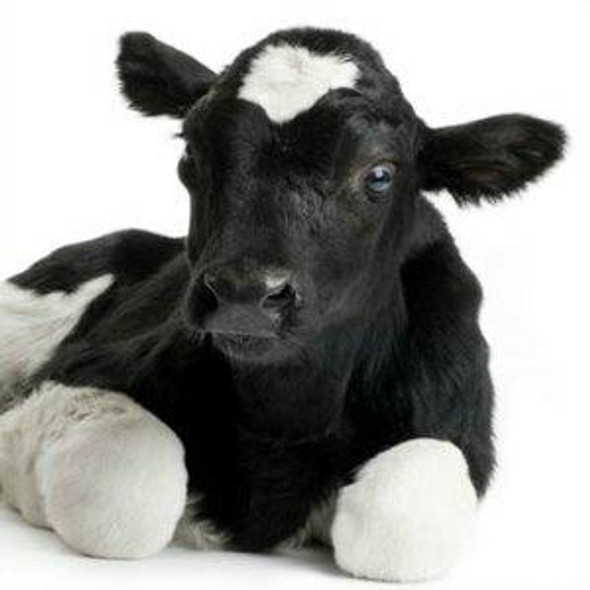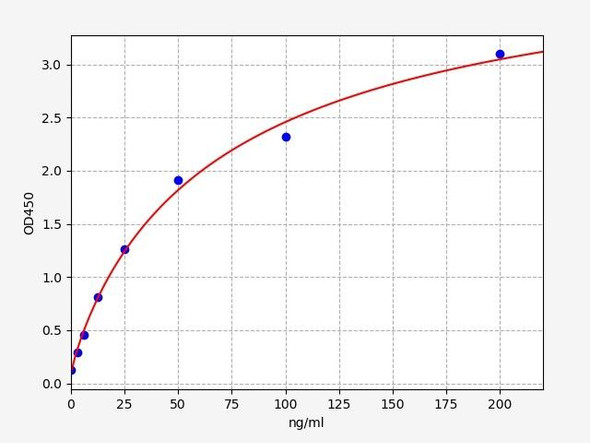Mouse Immunology ELISA Kits
Mouse CFB (Complement Factor B) ELISA Kit (MOES00897)
- SKU:
- MOES00897
- Product Type:
- ELISA Kit
- Size:
- 96 Assays
- Uniprot:
- P04186
- Sensitivity:
- 0.94ng/mL
- Range:
- 1.56-100ng/mL
- ELISA Type:
- Sandwich
- Synonyms:
- AHUS4, BF, BFD, CFAB, FB, FBI12, GBG, H2-Bf, PBF2, Properdin
- Reactivity:
- Mouse
- Sample Type:
- Serum, plasma and other biological fluids
- Research Area:
- Immunology
Description
| Assay type: | Sandwich |
| Format: | 96T |
| Assay time: | 4.5h |
| Reactivity: | Mouse |
| Detection Method: | Colormetric |
| Detection Range: | 1.56-100 ng/mL |
| Sensitivity: | 0.94 ng/mL |
| Sample Volume Required Per Well: | 100µL |
| Sample Type: | Serum, plasma and other biological fluids |
| Specificity: | This kit recognizes Mouse CFB in samples. No significant cross-reactivity or interference between Mouse CFB and analogues was observed. |
This ELISA kit uses Sandwich-ELISA as the method. The micro ELISA plate provided in this kit has been pre-coated with an antibody specific to Mouse CFB. Standards or samples are added to the appropriate micro ELISA plate wells and combined with the specific antibody. Then a biotinylated detection antibody specific for Mouse CFB and Avidin-Horseradish Peroxidase (HRP) conjugate are added to each micro plate well successively and incubated. Free components are washed away. The substrate solution is added to each well. Only those wells that contain Mouse CFB, biotinylated detection antibody and Avidin-HRP conjugate will appear blue in color. The enzyme-substrate reaction is terminated by adding Stop Solution and the color turns yellow. The optical density (OD) is measured spectrophotometrically at a wavelength of 450 nm ± 2 nm. The OD value is proportional to the concentration of Mouse CFB. The concentration of Mouse CFB in samples can be calculated by comparing the OD of the samples to the standard curve.
| UniProt Protein Function: | CFB: Factor B which is part of the alternate pathway of the complement system is cleaved by factor D into 2 fragments: Ba and Bb. Bb, a serine protease, then combines with complement factor 3b to generate the C3 or C5 convertase. It has also been implicated in proliferation and differentiation of preactivated B- lymphocytes, rapid spreading of peripheral blood monocytes, stimulation of lymphocyte blastogenesis and lysis of erythrocytes. Ba inhibits the proliferation of preactivated B-lymphocytes. Defects in CFB are a cause of susceptibility to hemolytic uremic syndrome atypical type 4 (AHUS4). An atypical form of hemolytic uremic syndrome. It is a complex genetic disease characterized by microangiopathic hemolytic anemia, thrombocytopenia, renal failure and absence of episodes of enterocolitis and diarrhea. In contrast to typical hemolytic uremic syndrome, atypical forms have a poorer prognosis, with higher death rates and frequent progression to end-stage renal disease. Susceptibility to the development of atypical hemolytic uremic syndrome can be conferred by mutations in various components of or regulatory factors in the complement cascade system. Other genes may play a role in modifying the phenotype. Belongs to the peptidase S1 family. 2 isoforms of the human protein are produced by alternative splicing. |
| UniProt Protein Details: | Protein type:EC 3. 4. 21. 47; Protease; Secreted; Secreted, signal peptide Chromosomal Location of Human Ortholog: 17 B1|17 18. 41 cM Cellular Component: blood microparticle; extracellular exosome; extracellular region; extracellular space Molecular Function:hydrolase activity; peptidase activity; serine-type endopeptidase activity; serine-type peptidase activity Biological Process: cell proliferation; complement activation; complement activation, alternative pathway; immune system process; innate immune response; proteolysis |
| UniProt Code: | P04186 |
| NCBI GenInfo Identifier: | 116126 |
| NCBI Gene ID: | 14962 |
| NCBI Accession: | P04186. 2 |
| UniProt Related Accession: | P04186 |
| Molecular Weight: | |
| NCBI Full Name: | Complement factor B |
| NCBI Synonym Full Names: | complement factor B |
| NCBI Official Symbol: | Cfb |
| NCBI Official Synonym Symbols: | B; Bf; C2; Fb; H2-Bf; AI195813; AI255840 |
| NCBI Protein Information: | complement factor B |
| UniProt Protein Name: | Complement factor B |
| UniProt Synonym Protein Names: | C3/C5 convertase |
| Protein Family: | Complement factor |
| UniProt Gene Name: | Cfb |
As the OD values of the standard curve may vary according to the conditions of the actual assay performance (e. g. operator, pipetting technique, washing technique or temperature effects), the operator should establish a standard curve for each test. Typical standard curve and data is provided below for reference only.
| Concentration (ng/mL) | O.D | Average | Corrected |
| 100 | 2.481 2.489 | 2.485 | 2.412 |
| 50 | 1.569 1.627 | 1.598 | 1.525 |
| 25 | 0.975 0.953 | 0.964 | 0.891 |
| 12.5 | 0.516 0.518 | 0.517 | 0.444 |
| 6.25 | 0.248 0.236 | 0.242 | 0.169 |
| 3.13 | 0.183 0.165 | 0.174 | 0.101 |
| 1.56 | 0.124 0.126 | 0.125 | 0.052 |
| 0 | 0.067 0.079 | 0.073 | -- |
Precision
Intra-assay Precision (Precision within an assay): 3 samples with low, mid range and high level Mouse CFB were tested 20 times on one plate, respectively.
Inter-assay Precision (Precision between assays): 3 samples with low, mid range and high level Mouse CFB were tested on 3 different plates, 20 replicates in each plate.
| Intra-assay Precision | Inter-assay Precision | |||||
| Sample | 1 | 2 | 3 | 1 | 2 | 3 |
| n | 20 | 20 | 20 | 20 | 20 | 20 |
| Mean (ng/mL) | 4.59 | 12.30 | 35.95 | 4.22 | 11.63 | 33.21 |
| Standard deviation | 0.24 | 0.58 | 1.51 | 0.29 | 0.54 | 1.71 |
| C V (%) | 5.23 | 4.72 | 4.20 | 6.87 | 4.64 | 5.15 |
Recovery
The recovery of Mouse CFB spiked at three different levels in samples throughout the range of the assay was evaluated in various matrices.
| Sample Type | Range (%) | Average Recovery (%) |
| Serum (n=5) | 96-110 | 101 |
| EDTA plasma (n=5) | 89-102 | 95 |
| Cell culture media (n=5) | 95-111 | 102 |
Linearity
Samples were spiked with high concentrations of Mouse CFB and diluted with Reference Standard & Sample Diluent to produce samples with values within the range of the assay.
| Serum (n=5) | EDTA plasma (n=5) | Cell culture media (n=5) | ||
| 1:2 | Range (%) | 99-111 | 96-110 | 97-114 |
| Average (%) | 104 | 101 | 105 | |
| 1:4 | Range (%) | 89-101 | 80-91 | 81-94 |
| Average (%) | 94 | 86 | 87 | |
| 1:8 | Range (%) | 88-99 | 81-92 | 88-102 |
| Average (%) | 94 | 86 | 95 | |
| 1:16 | Range (%) | 94-107 | 84-95 | 84-98 |
| Average (%) | 99 | 89 | 91 |
An unopened kit can be stored at 4°C for 1 month. If the kit is not used within 1 month, store the items separately according to the following conditions once the kit is received.
| Item | Specifications | Storage |
| Micro ELISA Plate(Dismountable) | 8 wells ×12 strips | -20°C, 6 months |
| Reference Standard | 2 vials | |
| Concentrated Biotinylated Detection Ab (100×) | 1 vial, 120 µL | |
| Concentrated HRP Conjugate (100×) | 1 vial, 120 µL | -20°C(shading light), 6 months |
| Reference Standard & Sample Diluent | 1 vial, 20 mL | 4°C, 6 months |
| Biotinylated Detection Ab Diluent | 1 vial, 14 mL | |
| HRP Conjugate Diluent | 1 vial, 14 mL | |
| Concentrated Wash Buffer (25×) | 1 vial, 30 mL | |
| Substrate Reagent | 1 vial, 10 mL | 4°C(shading light) |
| Stop Solution | 1 vial, 10 mL | 4°C |
| Plate Sealer | 5 pieces | |
| Product Description | 1 copy | |
| Certificate of Analysis | 1 copy |
- Set standard, test sample and control (zero) wells on the pre-coated plate and record theirpositions. It is recommended to measure each standard and sample in duplicate. Note: addall solutions to the bottom of the plate wells while avoiding contact with the well walls. Ensuresolutions do not foam when adding to the wells.
- Aliquot 100µl of standard solutions into the standard wells.
- Add 100µl of Sample / Standard dilution buffer into the control (zero) well.
- Add 100µl of properly diluted sample (serum, plasma, tissue homogenates and otherbiological fluids) into test sample wells.
- Cover the plate with the sealer provided in the kit and incubate for 90 min at 37°C.
- Aspirate the liquid from each well, do not wash. Immediately add 100µL of BiotinylatedDetection Ab working solution to each well. Cover the plate with a plate seal and gently mix. Incubate for 1 hour at 37°C.
- Aspirate or decant the solution from the plate and add 350µL of wash buffer to each welland incubate for 1-2 minutes at room temperature. Aspirate the solution from each well andclap the plate on absorbent filter paper to dry. Repeat this process 3 times. Note: a microplatewasher can be used in this step and other wash steps.
- Add 100µL of HRP Conjugate working solution to each well. Cover with a plate seal andincubate for 30 min at 37°C.
- Aspirate or decant the solution from each well. Repeat the wash process for five times asconducted in step 7.
- Add 90µL of Substrate Reagent to each well. Cover with a new plate seal and incubate forapproximately 15 min at 37°C. Protect the plate from light. Note: the reaction time can beshortened or extended according to the actual color change, but not by more than 30min.
- Add 50 µL of Stop Solution to each well. Note: Adding the stop solution should be done inthe same order as the substrate solution.
- Determine the optical density (OD value) of each well immediately with a microplate readerset at 450 nm.






